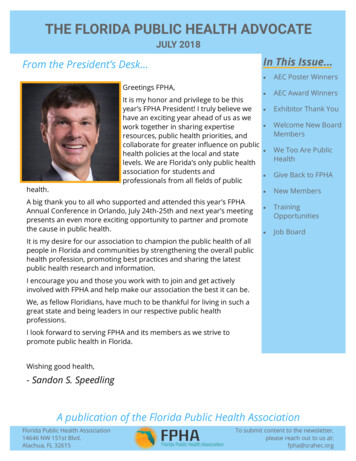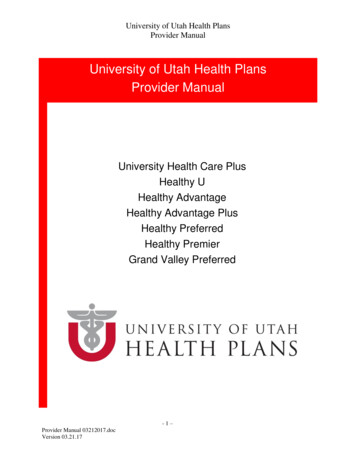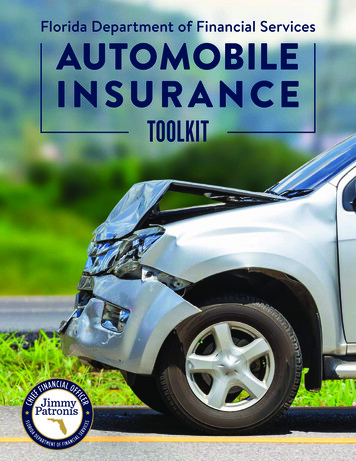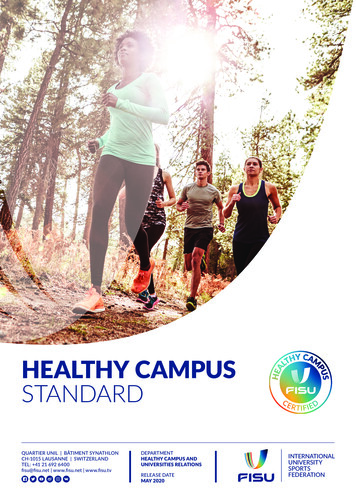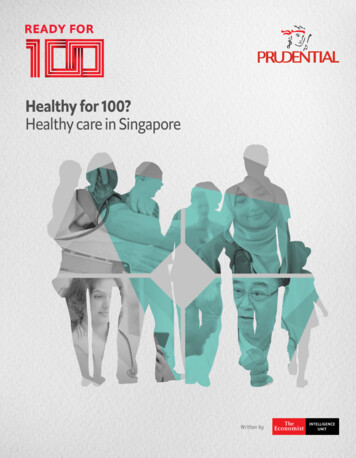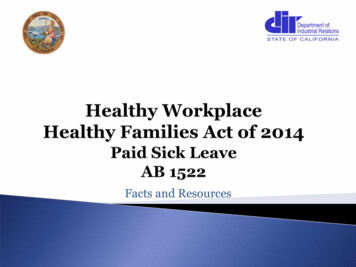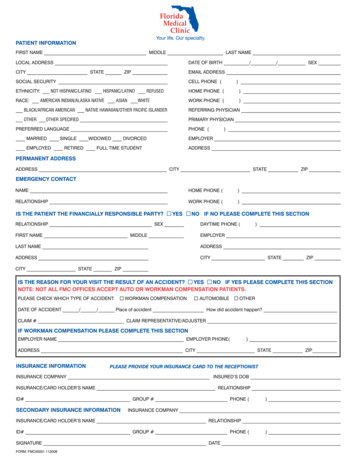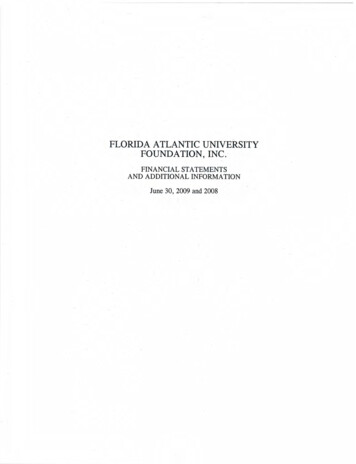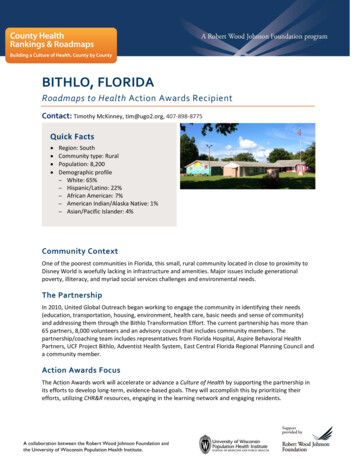
Transcription
BITHLO, FLORIDARoadmaps to Health Action Awards RecipientContact: Timothy McKinney, tim@ugo2.org, 407-898-8775Quick Facts Region: SouthCommunity type: RuralPopulation: 8,200Demographic profile– White: 65%– Hispanic/Latino: 22%– African American: 7%– American Indian/Alaska Native: 1%– Asian/Pacific Islander: 4%Community ContextOne of the poorest communities in Florida, this small, rural community located in close to proximity toDisney World is woefully lacking in infrastructure and amenities. Major issues include generationalpoverty, illiteracy, and myriad social services challenges and environmental needs.The PartnershipIn 2010, United Global Outreach began working to engage the community in identifying their needs(education, transportation, housing, environment, health care, basic needs and sense of community)and addressing them through the Bithlo Transformation Effort. The current partnership has more than65 partners, 8,000 volunteers and an advisory council that includes community members. Thepartnership/coaching team includes representatives from Florida Hospital, Aspire Behavioral HealthPartners, UCF Project Bithlo, Adventist Health System, East Central Florida Regional Planning Council anda community member.Action Awards FocusThe Action Awards work will accelerate or advance a Culture of Health by supporting the partnership inits efforts to develop long-term, evidence-based goals. They will accomplish this by prioritizing theirefforts, utilizing CHR&R resources, engaging in the learning network and engaging residents.
DUPAGE COUNTY, ILLINOISRoadmaps to Health Action Awards RecipientContact: Sarah Troll, sarah.troll@dupagehealth.org, 630-221-7147Quick Facts Region: MidwestCommunity type: SuburbanPopulation: 932,708Demographic profile– White: 82%– Hispanic/Latino: 14%– African American: 5%– American Indian/Alaska Native: 1%– Asian/Pacific Islander: 11%Community ContextDuPage is the second largest county and among the wealthiest and healthiest in the state. There havebeen significant increases in Hispanic or Latino (60%) and immigrant populations (24%) between 2000and 2013. The number of low-income people has also grown more recently.The PartnershipImpact DuPage, a partnership comprised local government, funders, healthcare and human serviceorganizations, uses a Collective Impact approach to assessment, planning and community action. Thepartnership has five priority areas: Access to Health Services, Affordable Housing, Mental Health,Substance Abuse and Healthy Lifestyles. The coaching team includes the DuPage County HealthDepartment, DuPage Federation on Human Services Reform, DuPage Mayors and Managers Conference,DuPage Health Coalition and DuPage Foundation.Action Awards FocusThe Action Awards work will accelerate or advance a Culture of Health by targeting affordable housing,the most complex of the community’s five priorities. Engagement, assessment and Collective Impactactivities will be conducted in order to better understand housing needs, build trust with residents andcreate a common agenda for addressing affordable housing in DuPage County.
FLINT, MICHIGANRoadmaps to Health Action Awards RecipientContact: Lauren Holaly-Zembo, lholaly@crim.org, 810-235-3396Quick Facts Region: MidwestCommunity type: UrbanPopulation: 101,558Demographic profile– White: 36%– Hispanic/Latino: 4%– African American: 57%– American Indian/Alaska Native: 1%– Asian/Pacific Islander: 1%Community ContextOnce the epicenter of the automotive industry as the birthplace of General Motors, the city now facesmajor challenges related to family and social support and community safety issues. For example, Flint’sviolent crime rate is more than 400% of the national average, there are more than 22,000 vacantproperties in the city, and the school district student population has dropped from 46,000 to 7,207.Collectively, these challenges serve as major risk factors for poor health.The PartnershipThe Flint Community Education Initiative is led by the Crim Fitness Foundation, which has served as aconvener for health and fitness programming and community engagement related to policy, systemsand environmental change initiatives within the county and region. The Action Awards opportunity hasallowed the Crim to convene a partnership to specifically address health needs through thedevelopment and delivery of programs and services in Flint Community Schools. The coaching teamincludes Crim Fitness Foundation, Greater Flint Health Coalition, Genesee County Health Department,Mott Children’s Health Center, Flint Community Schools and Genesee Health System.Action Awards FocusThe Action Awards work will accelerate or advance a Culture of Health by creating systems changes tointegrate a broad definition of health in four schools, share data across partners (schools and healthsystem), ensure access to care through referrals and better coordinate services that impact socialdeterminant of health.
FRANKLIN COUNTY, MASSACHUSETTSRoadmaps to Health Action Awards RecipientContact: Phoebe Walker, walker@frcog.org, 413-774-3167 x102Quick Facts Region: NortheastCommunity type: RuralPopulation: 71,372Demographic profile– White: 92%– Hispanic/Latino: 3%– African American: 1%– American Indian/Alaska Native: 1%– Asian/Pacific Islander: 1%Photo Credit: The RecorderCommunity ContextFranklin County is comprised of 26 towns over 750 square miles. Median household income and medianfamily income are substantially lower than state levels. Rural poverty, isolation and very limited publictransportation contribute to challenges in accessing healthy foods, physical activity and health care.The PartnershipThe Community Benefits Advisory Council of Baystate Franklin Medical Center’s mission is to promotecommunity wellness and improve access to care for vulnerable populations. The Council spearheads thecreation of a community health needs assessment for the region every three years, identifies priorityhealth issues and makes grants available to address them. The coaching team includes representativesfrom Franklin Regional Council of Governments (of which all 26 Franklin County towns are members);Baystate Franklin Medical Center; Community Action of the Franklin, Hampshire and North QuabbinRegions; Franklin County Home Care Corporation; and University of Massachusetts School of PublicHealth and Health Sciences.Action Awards FocusThe Action Awards work will accelerate or advance a Culture of Health by improving health outcomesthrough more rigorous evaluation and the involvement of community members in planning andimplementing programs. The council coordinates the community health assessment process for thehospital, and this coaching and funding award will help improve that process.
JEFFERSON COUNTY, ALABAMARoadmaps to Health Action Awards RecipientContact: Kadie Peters, kpeters@uwca.org, 205-458-2168Quick Facts Region: SouthCommunity type: UrbanPopulation: 658,466Demographic profile– White: 52%– Hispanic/Latino: 4%– African American: 42%– American Indian/Alaska Native: 1%– Asian/Pacific Islander: 1%Community ContextJefferson County is the largest in the state, and each of the 35 municipalities and 12 school districts hasits own political structure. The geographic concentration of poverty is similar to the concentration ofBlacks in these same census tracts, and life expectancy can vary by up to 20 years across census tracts.The PartnershipThe Jefferson County Health Action Partnership is part of a larger Collective Impact initiative and focuseson five strategic issue areas: Advancing Health Equity, Improving Mental Health, Optimizing Healthcare,Promoting Healthy Lifestyles and Optimizing the Built Environment, Transportation & Safety. Establishedin 2007, it is a coalition of more than 80 organizational members. The coaching team includes partnersfrom the United Way of Central Alabama, Community Foundation of Greater Birmingham, JeffersonCounty Health Department, Midfield City Schools and Freshwater Land Trust.Action Awards FocusThe Action Awards work will accelerate or advance a Culture of Health by aligning health equitystrategies and actions for greater impact in the community. The partnership will focus on helping tosupport each of their new priority groups (e.g., cultivating leadership roles for residents, facilitatingcommunity-wide discussions, addressing health equity, creating learning support structures and more),bringing a more intentional focus to the partnership's work, and beginning to genuinely address equityand resident engagement.
JOPLIN, MISSOURIRoadmaps to Health Action Awards RecipientContact: Lisa Nelson, lcnelson@freemanhealth.com, 417-347-4987Quick Facts Region: MidwestCommunity type: RuralPopulation: 51,316Demographic profile– White: 88%– Hispanic/Latino: 5%– African American: 3%– American Indian/Alaska Native: 2%– Asian/Pacific Islander: 2%Community ContextThe Joplin region is characterized by low wages, significant health risks (smoking, teen pregnancy andobesity), low educational attainment and a history of environmental damage due to mining practices.Situated at an interstate crossroads, there are numerous fast food chains in the region and food equityis a concern.The PartnershipThe Joplin Area Food Action Network (JFAN) partnership strives to increase access to healthy, locallygrown food. Members include businesses, non-profit organizations, local government agencies, faithbased organizations and individuals. JFAN is not limited to the Joplin City limits and intends to include allareas where local residents live, work and play. The coaching team is comprised of representatives fromFreeman Health System, Webb City Farmer’s Market, Joplin Health Department, Economic SecurityOrganization, University of Missouri Food & Nutrition Extension Program and Joplin Family Y.Action Awards FocusThe Action Awards work will accelerate or advance a Culture of Health by ensuring that the partnership’sstrategies are community led. Leveraging previous Roadmaps coaching, they will further engagevulnerable populations and seek successful strategies to address food insecurity while building on theassets and lessons learned about resilience that arose from the tornado devastation in 2011.
KANSAS CITY, KANSAS & MISSOURIRoadmaps to Health Action Awards RecipientContact: Lucinda Noches Talbert, lntalbert@kchealthykids.org, 816-523-5353Quick Facts Region: MidwestCommunity type: UrbanPopulation – 145,786 (KCK), 459,787 (KCM)Demographic profile– White: 40% (KCK), 55% (KCM)– Hispanic/Latino: 28% (KCK), 10% (KCM)– African American: 27% (KCK), 30% (KCM)– American Indian/Alaska Native: 1% (KCK), 1% (KCM)– Asian/Pacific Islander: 3% (KCK), 3% (KCM)Community ContextKansas City, Kansas (KCK) and Kansas City, Missouri (KCM) are adjacent cities that form the urban core ofGreater Kansas City. The region is racially and ethnically diverse, and is impacted by poverty. For manyyears, Kansas City has been influenced by urban sprawl which has led to the deterioration of the urbancore and physical isolation of Black, Hispanic and poor residents.The PartnershipThe Bi-State Healthy Communities Initiative focuses on increasing opportunities for physical activity,improving access to affordable, healthy foods in under-resourced neighborhoods, and leveragingcommunity assets that improve health and quality of life for under-resourced communities in KCK andKCM. The coaching team includes representatives from KC Healthy Kids, Rosedale DevelopmentAssociation, Healthy Communities Wyandotte, Ivanhoe Neighborhood Council, Upper Room andVineyard Neighborhood Association.Action Awards FocusThe Action Awards work will accelerate or advance a Culture of Health by scaling the Bi-State HealthyKids initiative through continued support of existing healthy neighborhood initiatives, building thecapacity of under-resourced neighborhoods that have not participated in healthy eating and active livingefforts, building individual leadership capabilities and bridging these efforts through peer learning.
LA CROSSE COUNTY, WISCONSINRoadmaps to Health Action Awards RecipientContact: Catherine Kolkmeier, ckolkmeier@uwlax.edu, 608-785-5151Quick Facts Region: MidwestCommunity type: UrbanPopulation: 116,713Demographic profile– White: 91%– Hispanic/Latino: 2%– African American: 1%– American Indian/Alaska Native: 1%– Asian/Pacific Islander: 2%Community ContextLa Crosse County is comprised of urban and rural communities. It has a higher rate of povertythan the state and a lower per capita income. The Hmong is the largest minority population,and the area was home to the Ho-Chunk Nation who are still part of the community.The PartnershipThe partnership is Healthy County: La Crosse, whose members address the needs ofunderserved populations. The coaching team includes representatives from the La CrosseMedical Health Science Consortium, Western Technical College, Gundersen Health System,Great Rivers United Way, University of Wisconsin-Extension and La Crosse County HealthDepartment.Action Awards FocusThe Action Awards work will accelerate or advance a Culture of Health by addressing healthmore broadly and re-designing the partnership's health improvement plan with attention tosocio-economic conditions. This will be accomplished by educating partners, seeking voices ofunderserved populations, incorporating what has worked in other communities, learning howto measure and evaluate socio-economic factors and educating decision makers.
LINN COUNTY, IOWARoadmaps to Health Action Awards RecipientContacts:Stephanie Neff, SLNeff12@gmail.com, 319-360-5558Linda Langston, Linda.Langston@linncounty.org, 319-892-5000Quick Facts Region: MidwestCommunity type: UrbanPopulation: 216,111Demographic profile– White: 89%– Hispanic/Latino: 3%– African American: 4%– American Indian/Alaska Native: 1%– Asian/Pacific Islander: 2%Community ContextIn Linn County, income, educational attainment and health factors/outcomes are all better than thestate average. The community’s response to the devastating floods in 2008 generated a much morecollaborative way of working together. However, challenges remain, including increases in rates ofoverweight/obesity, diabetes and asthma; increases in the unintentional injury rate; and disparities inaccess to medical services in rural areas.The PartnershipAfter participating in CHR&R’s Boundary Spanning Leadership program, the Linn County partnershipimplemented tools to develop a model for community coalition building and strategic planning, anddeveloped a cross-sector Food Environment Alliance to facilitate partnership relationships acrosssectors. Coaching team representatives include Blue Zones Project Cedar Rapids, Technical ConsultingServices, United Way of East Central Iowa, Cedar Rapids Community Schools and Linn County.Action Awards FocusThe Action Awards work will accelerate or advance a Culture of Health by further developing the FoodEnvironment Alliance as a model for increasing well-being and resilience within the community using theissue of nutrition as a starting point, with significant attention to community engagement in populationswith greatest health disparities and needs. The partnership will also grow its capacity to replicate othersuccessful local efforts, such as pilot work with the National Academies of Science focused on buildingand maintaining community resilience.
MANCHESTER, NEW HAMPSHIRERoadmaps to Health Action Awards RecipientContact: Anna Thomas, athomas@manchesternh.gov, 603-628-6003Quick Facts Region: NortheastCommunity type: UrbanPopulation: 109,364Demographic profile– White: 82%– Hispanic/Latino: 8%– African American: 4%– American Indian/Alaska Native: 1%– Asian/Pacific Islander: 4%Community ContextManchester is the largest community in New Hampshire and Northern New England. Although it islocated in a predominately rural and affluent state, Manchester is an urban community with publichealth challenges similar to those found in larger cities across the United States. Eight neighborhoods inManchester are considered Federal Poverty Areas.The PartnershipThe Manchester Neighborhood Health Improvement Strategy (NHIS) Leadership Team is thecollaborative that guides and monitors the community health improvement process for the GreaterManchester area. It includes representatives from government, health care, philanthropy and business,and neighborhood champions. The coaching team includes partners from the City of Manchester HealthDepartment, Dartmouth-Hitchcock Partners to Community Wellness, NeighborWorks Southern NewHampshire, Granite United Way and Manchester School District Innovation Zone.Action Awards FocusThe Action Awards work will accelerate or advance a Culture of Health by maximizing businessengagement and building on the community engagement the partnership has developed with theirCommunity Schools Initiative. Using a Collective Impact approach, the partnership will focus onstrategies to engage a diverse group of stakeholders to support the Manchester NHIS, reach vulnerablepopulations and define a role for businesses to foster public-private partnerships.
MONADNOCK REGION, NEW HAMPSHIRERoadmaps to Health Action Awards RecipientContact: Linda Rubin, LRubin@Cheshire-Med.COM, 603-354-5454 x3930Quick Facts Region: Northeast Community type: Rural Population: 103,000 Demographic profile (based on Cheshire County)– White: 95.9%– Hispanic/Latino: 1.7%– African American: 1%– American Indian/Alaska Native: 1%– Asian/Pacific Islander: 1.4%Community ContextThe region is abundant in natural beauty and community spirit. It also is challenged with socio-economicdisparities that are intensified by its rural landscape and diminishing state and local resources. CheshireCounty includes the City of Keene and 22 rural towns. The median household income is lower than thatof the state, and 505 residents live at or below 300% of the federal poverty level.The PartnershipThe Healthy Monadnock partnership was founded in 2007 by the Cheshire Medical Center with a 2020mission to make the region the healthiest community in the nation through engagement of champions(partners, organizations, schools and individuals) working to address the social determinants of healthand make the healthy choice the easy choice for everyone. Focus areas include living wages/jobs,healthy eating, active living, educational attainment and mental well-being. The coaching team includesrepresentatives from the Hanna Grimes Center (community development), Keene State College, KeeneUnitarian Universalist Church, W.S. Badger Company (business), City of Keene and Keene HousingAuthority.Action Awards FocusThe Action Awards work will accelerate or advance a Culture of Health by building on efforts to developand implement a living wage campaign, which the partnership began in January 2014. This will beaccomplished by engaging members most affected, building political will and sharing learning widely.
PETERSBURG, VIRGINIARoadmaps to Health Action Awards RecipientContact: Maghboeba Mosavel, mmosavel@vcu.edu, 804-628-2929Quick Facts Region: SouthCommunity type: UrbanPopulation: 32,000Demographic profile– White: 15%– Hispanic/Latino: 4%– African American: 79%– American Indian/Alaska Native: 1%– Asian/Pacific Islander: 1%Community ContextAccording to the 2014 County Health Rankings, Petersburg City was identified as the least healthycounty in Virginia, and ranked at the bottom on both health factors and health outcomes. Petersburg ispart of a region known as the Tri-Cities. Each of these communities has its own governing system, butthey work together to address and impact regional issues.The PartnershipThe Petersburg Wellness Consortium provides a space for collaboration among various entities workingin the Petersburg area to promote health and wellness, and to impact health outcomes. The coachingteam includes the city manager, a community activist and partners from Virginia CommonwealthUniversity, Virginia Department of Health – Crater Health District, the YMCA of Petersburg, the CameronFoundation and Virginia Cooperative Extension Service – Virginia State University.Action Awards FocusThe Action Awards work will accelerate or advance a Culture of Health by positioning the PetersburgWellness Consortium as an inclusive and sustainable umbrella organization to improve health inPetersburg. They will accomplish this by building on existing and emerging assets, sustaining currentpartnerships and developing new relationships with key organizations, and making changes that focuson policies, systems and environmental solutions.
RANCHO CUCAMONGA, CALIFORNIARoadmaps to Health Action Awards RecipientContact: Erika Lewis-Huntley, erika.lewis-huntley@cityofrc.us, 909-477-2700 x2008Quick Facts Region: WestCommunity type: SuburbanPopulation: 167,743Demographic profile– White: 43%– Hispanic/Latino: 35%– African American: 9%– American Indian/Alaska Native: 1%– Asian/Pacific Islander: 11%Community ContextRancho Cucamonga is an ethnically and racially diverse community in Southern California.After several decades of exponential population growth, vineyards and citrus groves havebeen replaced by sprawling housing and retail development. These environmental conditionswere major factors that have led to an increase in obesity and related health problems.The PartnershipHealthy RC is a comprehensive city-community partnership that is committed to playing anactive role in long-term policy, systems and environmental changes to support healthy livingand a sustainable community. Facilitated by the City Manager’s Office, the Healthy RCcollaborative consists of city departments, local residents and over 75 communitystakeholders with diverse expertise to improve complex community health issues. Thecoaching team includes representatives from the City Manager’s Office, non-profit agencies,the San Bernardino County Department of Public Health and community residents.Action Awards FocusThe Action Awards work will accelerate or advance a Culture of Health by identifying datadriven indicators and performance metrics to measure the impact the Healthy RC initiativehas made on the community. The development of the Healthy RC Evaluation Plan iscommunity driven, engaging residents, stakeholders and partner organizations to collect,analyze and interpret data, and to identify the tools and indicators to measure effectiveness.Data-driven indicators will align with the eight community health priorities identified in theHealthy RC Strategic Plan, and will inform implementation of policies, programs and plans.
SCHENECTADY, NEW YORKRoadmaps to Health Action AwardsContact: Erin Simao, buckenmeyere@ellismedicine.org, 518-831-7073Quick Facts Region: NortheastCommunity type: UrbanPopulation: 65,902Demographic profile– White: 58%– Hispanic/Latino: 11%– African American: 20%– American Indian/Alaska Native: 1%– Asian/Pacific Islander: 4%Community ContextGeographically, Schenectady is the second smallest county in upstate New York. Residents of the city aregenerally less affluent and less healthy than residents of the surrounding towns, with a poverty rate thatis nearly double that of the county. The city has a significant minority population comprised of WestIndians of Guyanese descent.The PartnershipThe Schenectady Coalition for a Healthy Community was originally established to ensure communityinput into the state-mandated merger of the three Schenectady hospitals. It has since become a broadforum supporting coordination of health care and services within the community, with virtually all localhealthcare/community service non-profits and local government agencies represented. The coachingteam includes partners from Ellis Medicine, United Way of the Greater Capital Region, SchenectadyCommunity Action Program, Schenectady Inner City Ministry and Schenectady County Public HealthServices. All members of the coaching team are also members of the Food Insecurity Workgroup of theCoalition.Action Awards FocusThe Action Awards work will accelerate or advance a Culture of Health by furthering the partnership’saccomplishments in addressing food insecurity. The partnership will build upon previous communityengagement and Roadmaps coaching, and utilize a Collective Impact approach to develop a strategicplan during the first six months, then move into planning and implementation.
SHENANDOAH, PENNSYLVANIARoadmaps to Health Action Awards RecipientContact: Kay Jones, kjones@schuylkillvision.com, 570-622-6097Quick Facts Region: NortheastCommunity type: RuralPopulation: 4,981Demographic profile– White: 80%– Hispanic/Latino: 17%– African American: 1%– American Indian/Alaska Native: 1%– Asian/Pacific Islander: 1%Community ContextShenandoah was once a prosperous coal mining community with a population of 30,000 before theindustry’s decline. Schuylkill County is part of the Appalachian Regional Commission, and has many ofthe challenges of other rural communities, including high rates of poverty and unemployment, and lowpostsecondary education rates.The PartnershipHealthy Shenandoah was created in 2014, beginning with a community assessment that informed thedevelopment of initial priorities and projects. The partnership includes representatives from education,social services, health care, business, faith and non-profit organizations as well as residents. Thecoaching team includes representatives from Schuylkill County’s VISION (the umbrella organization forHealthy Schuylkill), Schuykill County, Clinical Outcomes Group, Rite Aid and Senior Living Community.Action Awards FocusThe Action Awards work will accelerate or advance a Culture of Health by establishing safe, connectedwalking trails and effective programs to increase their use. The partnership will remain committed toaddressing resident engagement, especially among Hispanics in their community.
SPRINGFIELD, MISSOURIRoadmaps to Health Action Awards RecipientContact: Patricia Deck, pdeck@commpartnership.org, 417-888-2020Quick Facts Region: MidwestCommunity type: UrbanPopulation: 164,122Demographic profile– White: 87%– Hispanic/Latino: 4%– African American: 4%– American Indian/Alaska Native: 1%– Asian/Pacific Islander: 2%Community ContextLocated in the Ozark Mountains, Springfield is the third largest city in the state, and its size and physicallocation make it an educational, transportation, recreational and medical hub for the region. Theunemployment rate is 5.6%, and 22% of residents live below the poverty line.The PartnershipThe Community Partnership of the Ozarks’ Healthy Living Alliance works to develop and sustain ahealthy community where everyone can thrive. Their four focus areas are nutrition, physical activity,tobacco and access to preventive services. They also engage in efforts to address many areas ofeconomic distress including housing, education and access to care. The coaching team includes partnersfrom the Community Partnership of the Ozarks, Inc., Springfield-Greene County Health Department,CoxHealth, Missouri State University and Ozarks Regional YMCA. The Healthy Living Alliance is currentlytransitioning from the YMCA to the Community Partnership. The Alliance was created in 2011 withfunding from the Missouri Foundation for Health and expanded with a Community TransformationGrant.Action Awards FocusThe Action Awards work will accelerate or advance a Culture of Health by better positioning thepartnership to advocate and coordinate health efforts, and implementing and evaluating changestrategies. The partnership is utilizing a Collective Impact approach.
STAMFORD, CONNECTICUTRoadmaps to Health Action Awards RecipientContact: Vincent Tufo, vtufo@charteroakcommunities.org, 203-977-1400Quick Facts Region: NortheastCommunity type: UrbanPopulation: 126,456Demographic profile– White: 53%– Hispanic/Latino: 24%– African American: 14%– American Indian/Alaska Native: 1%– Asian/Pacific Islander: 8%Community ContextThe city has enjoyed significant economic growth and development in the last decade but struggles withpockets of poverty and health disparity. The county ranks high in health outcomes but low in otherhealth factors, and specific neighborhoods concentrated in Stamford’s West Side have significantdisparities in health, employment and income.The PartnershipSince its founding in 2012, the Vita Health and Wellness Collaborative has helped promote communityhealth, reduce health disparities, expand access to healthy foods, and promote health education and jobtraining/business development for residents at all skill and income levels. To date, they have leveragedmore than 125 million in public and private investments to make Stamford neighborhoods morewalkable, transit-accessible and connected. The coaching team includes representatives from CharterOak Communities, Stamford Hospital, the City of Stamford, AmeriCares Free Clinic, Family Centers andNorwalk Community College.Action Awards FocusThe Action Awards work will accelerate or advance a Culture of Health by designing an evaluationprocess that is inclusive, iterative and informative. It will address the partnership’s five areas ofconcentration: Health and Wellness in the Community, Healthy Eating/Urban Agriculture and Nutrition,Active Living/Parks and Recreation, Good Jobs and Local Businesses, and Hospital and CommunityConnections.
SWANTON, VERMONTRoadmaps to Health Action Awards RecipientContact: Molly Lambert, mpllambert@yahoo.com, 802-868-4989Quick Facts Region: NortheastCommunity type: RuralPopulation: 6,427Demographic profile– White: 93%– Hispanic/Latino: 1%– African American: 1%– American Indian/Alaska Native: 2.5%– Asian/Pacific Islander: 1%Community ContextSwanton is governed by two municipal bodies, Swanton Village and Swanton Town, and sits on 41,408acres of land. The Abenaki tribal headquarters, Lake Champlain and the Missisquoi Wildlife Refuge arewithin Swanton’s borders. Swanton
Department, DuPage Federation on Human Services Reform, DuPage Mayors and Managers Conference, DuPage Health Coalition and DuPage Foundation. Action Awards Focus . The Action Awards wo
